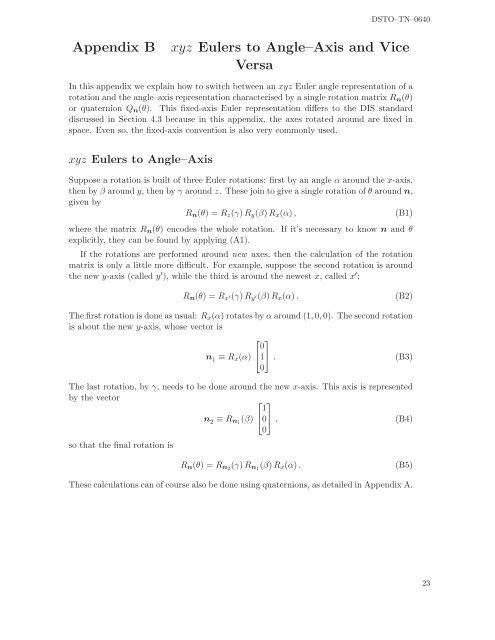Using Rotations to Build Aerospace Coordinate Systems - Defence ...
Using Rotations to Build Aerospace Coordinate Systems - Defence ...
Using Rotations to Build Aerospace Coordinate Systems - Defence ...
You also want an ePaper? Increase the reach of your titles
YUMPU automatically turns print PDFs into web optimized ePapers that Google loves.
DSTO–TN–0640Appendix B xyz Eulers <strong>to</strong> Angle–Axis and ViceVersaIn this appendix we explain how <strong>to</strong> switch between an xyz Euler angle representation of arotation and the angle–axis representation characterised by a single rotation matrix R n (θ)or quaternion Q n (θ). This fixed-axis Euler representation differs <strong>to</strong> the DIS standarddiscussed in Section 4.3 because in this appendix, the axes rotated around are fixed inspace. Even so, the fixed-axis convention is also very commonly used.xyz Eulers <strong>to</strong> Angle–AxisSuppose a rotation is built of three Euler rotations: first by an angle α around the x-axis,then by β around y, then by γ around z. These join <strong>to</strong> give a single rotation of θ around n,given byR n (θ) = R z (γ)R y (β)R x (α),(B1)where the matrix R n (θ) encodes the whole rotation. If it’s necessary <strong>to</strong> know n and θexplicitly, they can be found by applying (A1).If the rotations are performed around new axes, then the calculation of the rotationmatrix is only a little more difficult. For example, suppose the second rotation is aroundthe new y-axis (called y ′ ), while the third is around the newest x, called x ′ :R n (θ) = R x ′(γ)R y ′(β)R x (α).(B2)The first rotation is done as usual: R x (α) rotates by α around (1, 0, 0). The second rotationis about the new y-axis, whose vec<strong>to</strong>r is⎡ ⎤0n 1 ≡ R x (α) ⎣1⎦ .(B3)0The last rotation, by γ, needs <strong>to</strong> be done around the new x-axis. This axis is representedby the vec<strong>to</strong>r⎡ ⎤1n 2 ≡ R n1 (β) ⎣0⎦ ,(B4)0so that the final rotation isR n (θ) = R n2 (γ)R n1 (β)R x (α).(B5)These calculations can of course also be done using quaternions, as detailed in Appendix A.23
















